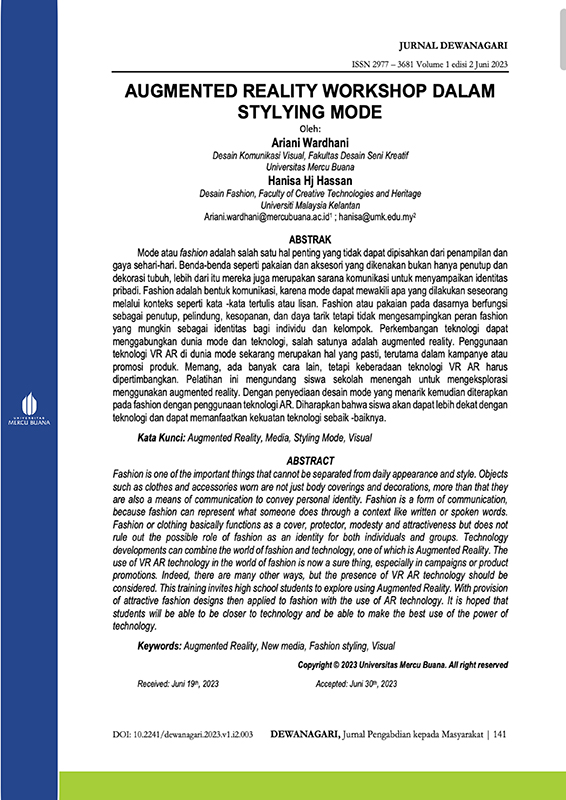
AUGMENTED REALITY WORKSHOP DALAM STYLYING MODE
Abstract
Fashion is one of the important things that cannot be separated from daily appearance and style. Objects such as clothes and accessories worn are not just body coverings and decorations, more than that they are also a means of communication to convey personal identity. Fashion is a form of communication, because fashion can represent what someone does through a context like written or spoken words. Fashion or clothing basically functions as a cover, protector, modesty and attractiveness but does not rule out the possible role of fashion as an identity for both individuals and groups. Technology developments can combine the world of fashion and technology, one of which is Augmented Reality. The use of VR AR technology in the world of fashion is now a sure thing, especially in campaigns or product promotions. Indeed, there are many other ways, but the presence of VR AR technology should be considered. This training invites high school students to explore using Augmented Reality. With provision of attractive fashion designs then applied to fashion with the use of AR technology. It is hoped that students will be able to be closer to technology and be able to make the best use of the power of technology.
Keywords
Full Text:
PDFReferences
Azuma, R. 1997, “A Survey of Augmented Reality.” Presence: Teleoperators and Virtual Environments 6, no.4, pp. 355- 385.
Azuma, R , Baillot, Y, Behringer, R, Feiner, S, Julier, S and MacIntyre, B., 2001, “Recent Advances in Augmented Reality.” IEEE Computer Graphics and Applications (6), pp. 34-47.
Bornik , A, Beichel ,R, Reitinger ,B, Gotschuli ,G, Sorantin, E, Leberl, F and Sonka, M 2003, “Computer aided liver surgery planning: An augmented reality approach.” Medical Imaging 2003: Visualization and Display, Proceedings of SPIE, volume 5029.
Caudell, Thomas , P and Mizell, Dw 1992, “Augmented Reality: An Application of Heads-Up Display Technology to Manual Manufacturing Processes,” Proceedings of Hawaii International Conference on System Sciences, pp. 659-669.
Chinthammit, Winyu, Burstein, R , Seibel, E and Furness, T., 2001, ‘Head tracking using the Virtual Retinal Display,’ Second IEEE and ACM International Symposium on Augmented Reality, October 29-30, New York, NY.
Drascic, D, Grodski, JJ, Milgram,P, Ruffo,K, Wong,P and Zhai, S 1993, “ARGOS: A Display System for Augmenting Reality”, Video Proceedings of INTERCHI '93: Human Factors in Computing Systems (Amsterdam, the Netherlands, 24-29 April 1993). ACM SIGGRAPH Technical Video Review, Volume 88. Extended abstract in Proceedings of INTERCHI '93, pp. 521.
Durlach, Nathaniel, I and Mavor, AS 1995, “Virtual Reality: Scientific and Technological Challenges.” Report of the Committee on Virtual Reality Research and Development to the National Research Council) National Academy Press (1995). ISBN 0-309-05135-5.
Fitzmaurice and George, 1993, “Situated Information Spaces: Spatially Aware Palmtop Computers.” CACM 36, 7 (July 1993), pp. 38-49.
Gervautz, M, Szalavári, Z and Eckstein, E, 1998, “Collaborative gaming in augmented reality.” ACM Symposium on Virtual reality software and technology, Taipei, Taiwan.
Kancherla, Anantha, R, Rolland,Jp, Wright, Dl and Burdea, G 1995, “A Novel Virtual Reality Tool for Teaching Dynamic 3D Anatomy.” Proceedings of Computer Vision, Virtual Reality, and Robotics in Medicine '95 (CVRMed '95) (Nice, France, 3-6 April 1995), pp. 163-169.
Kaufmann, H, Schmalstieg, D and Wagner, M, 2000, “Construct3D: A Virtual Reality Application for Mathematics and Geometry Education,” Education and Information Technologies 5:4 (December 2000), pp. 263- 276.
Milgram ,P and Kishino,F 1994, “A Taxonomy of Mixed Reality Visual Display.” IEICE Trans. Information System, vol.E77-D, no.12, pp. 1321-1329.
Milgram, P, Zhai,S, Drascic, D and Grodski, Jj 1993, “Applications of Augmented Reality for Human-Robot Communication.” Proceedings of International Conference on Intelligent Robotics and Systems (Yokohama, Japan, July 1993), 1467-1472.
Rose, Eric, Breen,D, Ahlers, K, Crampton,C, Tuceryan,M, Whitaker, R and Greer, D 1995, “Annotating Real-World Objects Using Augmented Reality.” Proceedings of Computer Graphics International '95 (Leeds, UK, 25-30 June 1995), pp. 357-370.
Sims, Dave 1994, “New Realities in Aircraft Design and Manufacture”, IEEE Computer Graphics and Applications 14.
State, Andrei, Mark, Al, Gentaro , H, William, Fg, Mary Cw, Henry, F and Pisano, Ed 1996, “Techniques for Augmented-Reality Systems: Realizing Ultrasound-Guided Needle Biopsies.” Proceedings of SIGGRAPH ‘96, pp. 439-446.
Silva, R, Oliveira, Jc and Giraldi, Ga 2003, “Introduction to Augmented Reality.” viewed 12 August 2007, www.lncc.br/~jauvane/papers/RelatorioTecnicoLNCC- 2503.pdf
Thalmann ,N, Thalmann, D, Tolga, K and Pandzic, Is 1998, “Nonverbal Communication Interface for Collaborative Virtual Environments.”, Proc. Computer Graphics International 1998.
Tuceryan, Mihran, Greer,Ds, Whitaker, Rt, Breen,D, Crampton,C, Rose,E and Ahlers, Kh 1995, “Calibration Requirements and Procedures for Augmented Reality” IEEE Transactions on Visualization and Computer Graphics 1, 3 (September 1995), pp. 255-273.
Wagner, D, Pintaric,T, Ledermann,F and Schmalstieg, D 2005, ‘Towards Massively Multi-User Augmented Reality on Handheld Devices,’ Vienna University of Technology.
Wursthorn, S, Coelho, Ah and Staub, G 2004, “Applications for Mixed Reality.”, XXth ISPRS Congress, Istanbul, Turkey.
Yamamoto, H 1999, ‘Case Studies of Producing Mixed Reality Worlds’, IEEE SMC '99 Conference Proceedings. Volume: 6, pp. 42-47
Refbacks
- There are currently no refbacks.
Jurnal DEWANAGARI : Jurnal Pengabdian kepada Masyarakat (PkM) Desain dan Seni
Fakultas Desain dan Seni Kreatif
Universitas Mercu Buana
Gedung C Lantai 2
Jl. Raya Meruya Selatan no.1, Kembangan, Jakarta 11650
Tlp./Fax: +62215871335
Journal International Standard Serial Number (ISSN) Registration:
Tools for Citations & Plagiarism Detection:

Ciptaan disebarluaskan di bawah Lisensi Creative Commons Atribusi-NonKomersial 4.0 Internasional









